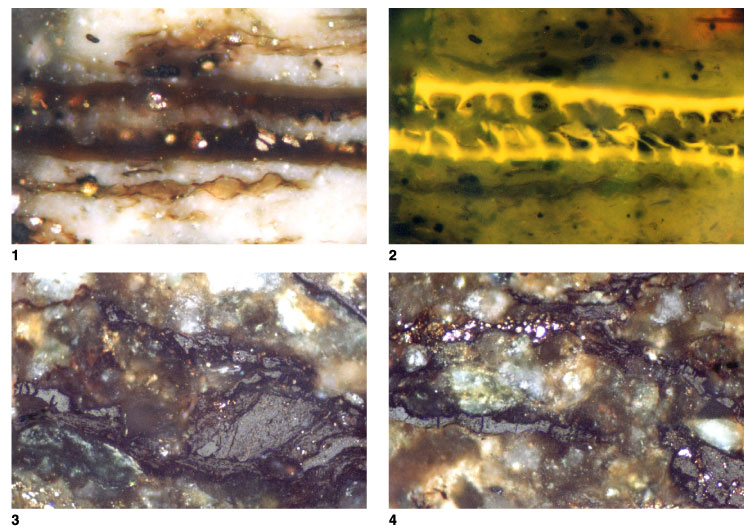
Plate P13.
Dispersed organic matter. 1.
T5842; Hole 1115C; 514.24 mbsf. Leaf preserved in claystone. The leaf no longer
contains the tissues within the cuticle (mesophyll tissue). However, these must
have been there at the time of deposition, otherwise the two cuticle surfaces
would have tended to be torn apart. Subsequent diagenesis has apparently removed
these tissues. The amber-colored wisps are probably also derived from leaf
tissue (reflected light; field width = 0.22 mm; mean vitrinite reflectance =
0.29%). 2. T5842; Hole
1115C; 514.24 mbsf. Same as figure 1, but in fluorescence mode. The smooth
surfaces of the cutinite represent the outer leaf surfaces, and the inner
saw-toothed appearance is typical of leaf cuticles. The projection bounds the
palisade cells. Commonly, palisade cells are preserved as vitrinite, and their
absence in this occurrence suggests strong biochemical decay has occurred,
leaving the relatively refractory cuticle intact (reflected light; field width =
0.22 mm; mean vitrinite reflectance = 0.29%). 3.
T5856; Hole 1116A; 110.93 mbsf. DOM comprising telovitrinite that appears to
represent in situ root tissue. Elongate structures such as these do not normally
remain intact during transport. Therefore, an in situ origin is likely
(reflected light; field width = 0.56 mm; mean vitrinite reflectance = 0.34%). 4.
T5856; Hole 1116A; 110.93 mbsf. Elongate and anastomosing occurrences of
telovitrinite that appear to represent in situ root tissue. Elongate structures
such as these do not normally remain intact during transport. Therefore, an in
situ origin is likely. Pyritization of the vitrinite has occurred (reflected
light; field width = 0.56 mm; mean vitrinite reflectance = 0.34%). Click on
image or number to see enlargement.



![]()